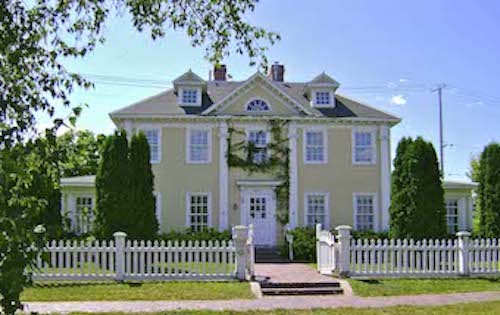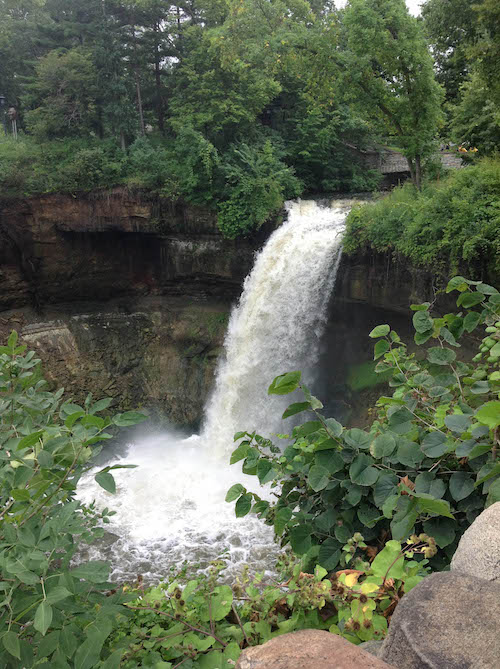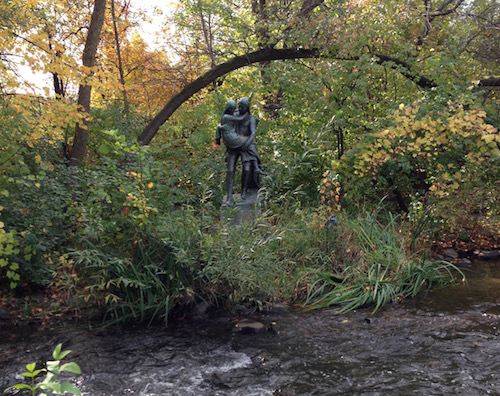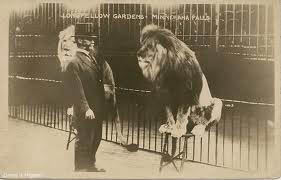
LONGFELLOW HOUSE HISTORY
4800 Minnehaha Avenue South, Minneapolis, MN 55417
The Minnesota School of Botanical Art welcomes you to our home at Longfellow House, on the edge of Minnehaha Park in Minneapolis. This wonderful building that we now occupy, and the surrounding grounds and garden, are part of the Minneapolis Park System, which manages and maintains them. Both the house and its location have intriguing histories, layered with quirks and contradictions.
The Longfellow House and lawns abut the northern bank of Minnehaha Creek, just a short walk upstream from Minnehaha Falls. The waterfall and stream share their names with the "princess" Minnehaha, wife of the hero Hiawatha in Henry Wadsworth Longfellow's long poem "The Song of Hiawatha," published in 1855. Curiously, the waterfall was not originally named for Minnehaha, nor did Hiawatha carry her over the creek above the waterfall. We can be sure of this last because the Hiawatha story is actually an Iroquois legend, from the area of present day New York State. His story, and that of Minnehaha, were mixedtogether--along with many others from Great Lakes tribes--by Henry Rowe Schoolcraft, ethnographer, Indian agent and explorer (he established Lake Itasca as the Mississippi's headwaters) of the Ozarks and of the upper Great Lakes.

According to Mary H. Eastman, the Dacotah people of the time did call the falls Minnehaha, which simply meant "waterfall," and was not the name of a legendary person to them. In fact, the story elements that Longfellow connected to his heroine were from Ojibwe (Anishenabe) stories learned by Schoolcraft from his part-Ojibwe wife, who was from Upper Michigan. Longfellow took the name of his character Minnehaha from the falls; the falls were not named for her. Longfellow was very much aware of the legends collected by Schoolcraft, and also of accounts of the country and people around Fort Snelling (Mary Eastman's 1849 book Dacotah or Life and Legends of the Sioux Around Fort Snelling), and is said to have been further inspired by an 1855 photograph of Minnehaha Falls, taken by Alexander Hessler, better known for his 1860 photographs of Abraham Lincoln. Longfellow never visited Minnehaha Falls himself.
As you may have guessed--or known--Mary Eastman was the wife of Seth Eastman, prominent military draftsman and artist, and Commander at Fort Snelling from 1841 to 1849. He illustrated Mary's above-mentioned book, and also Schoolcraft's later six volume history of American Indian tribes (1851-1857).

The great success of Longfellow's "Hiawatha" poem made Minnehaha Falls a tourist destination. By 1900 it was home to a variety of facilities and attractions, including a campground, picnic area, a small zoo, and up to thirty-nine trains per day at its small depot, which still stands. The area was the first acreage to be purchased by the newly formed Minnesota State Parks Commission, in 1885. The land was later transferred to the City of Minneapolis, and has since been part of the Minneapolis Parks Department.
The tale now turns toward Longfellow House. Robert "Fish" Jones, a flamboyant Minneapolis fishmonger and merchant, began in the 1880's to establish a private zoo at the edge of downtown, on the present site of St. Mary's Basilica, near Loring Park. His animal collection grew large, and by 1905 he needed to relocate. His new zoo compound, soon to be opened to the public as the Longfellow Zoological Garden, was on Minnehaha Creek, above the falls, near the present Minnehaha Parkway bridge that crosses over Hiawatha Avenue. The menagerie continued to expand, and the grounds were eventually developed to include ponds, animal sculptures, promenades, and a pavilion. The array of exotic animals included, over the years, camels, tigers, zebras, bears, seals, orangutans. and a lion well-known as Hiawatha. Reports that seals escaped into Minnehaha Creek and over the falls were never confirmed.


In 1906 Jones built a house beside the creek and near his Garden. In celebration of the area's literary associations, the house was a two thirds scale replica of the Cambridge, Massachusetts home of the author of "Hiawatha," and came to be known locally as Longfellow House. Robert "Fish" Jones lived in the house, and continued to operate the Longfellow Zoological Garden, until his death in 1930.
The actual Longfellow home in Cambridge is known there as Craigie House, after one of its prior owners. It was given to Longfellow and his bride, Frances Appleton, by her father Nathaniel Appleton, in 1843.
Longfellow House in Minneapolis has not always been as it is now. In 1934 it was deeded to the Minneapolis Park Board, which in turn sold it to the Minneapolis Public Library. After WPA renovation, it opened in 1937 as Longfellow Community Library, closing in 1968 after the opening of Nokomis Community Library. In 1994, as part of the expansion of Hiawatha Avenue, the structure was lifted and moved eastward to its current location.

On January 7, 2013 Longfellow House became the residence of the Minnesota School of Botanical Art. Established in 2001, the School will expand its offerings of botanical art classes. Art exhibitions and celebratory openings will be scheduled throughout the year.
We invite you to stop by to discover the renaissance in botanical art!


